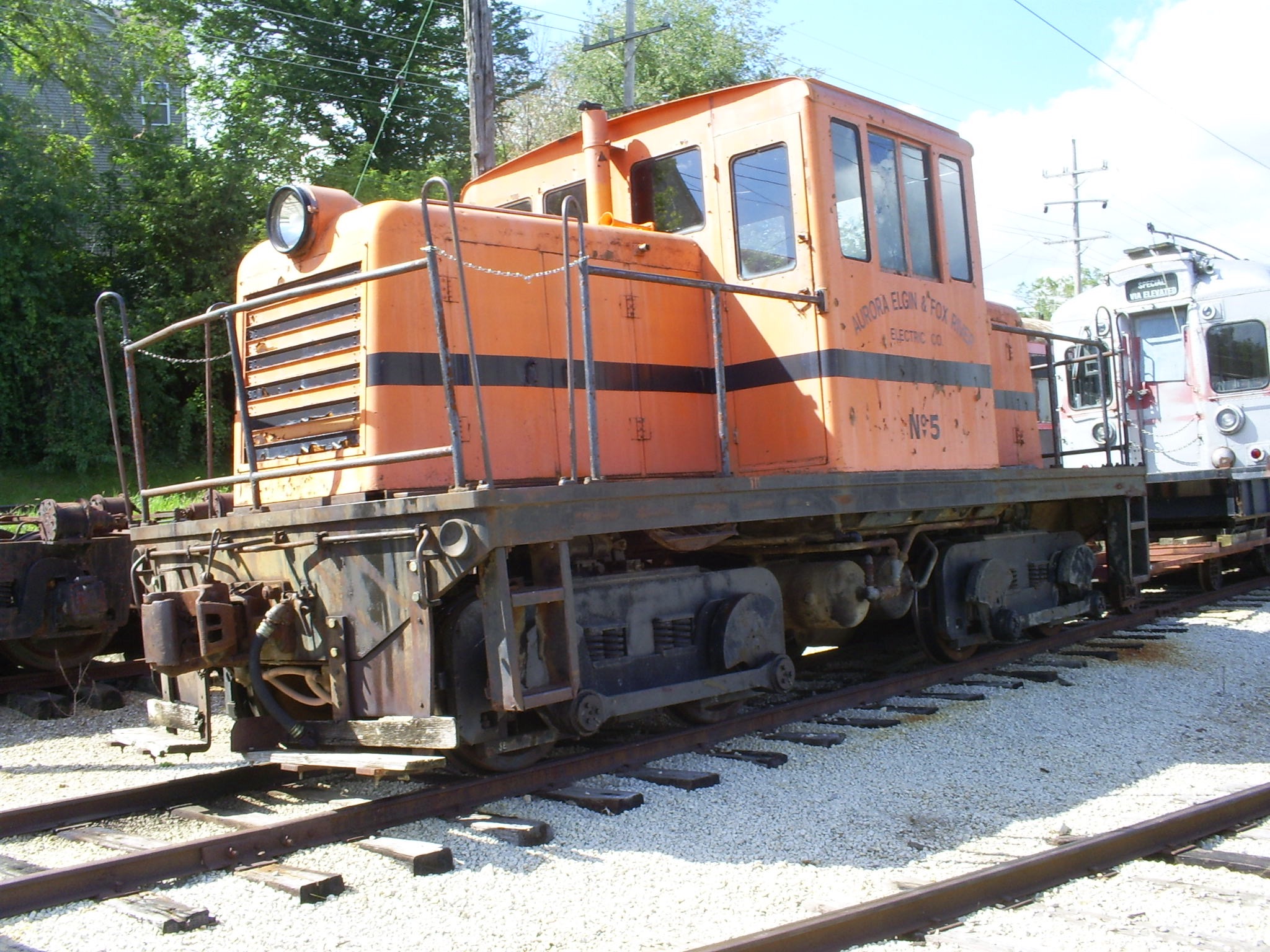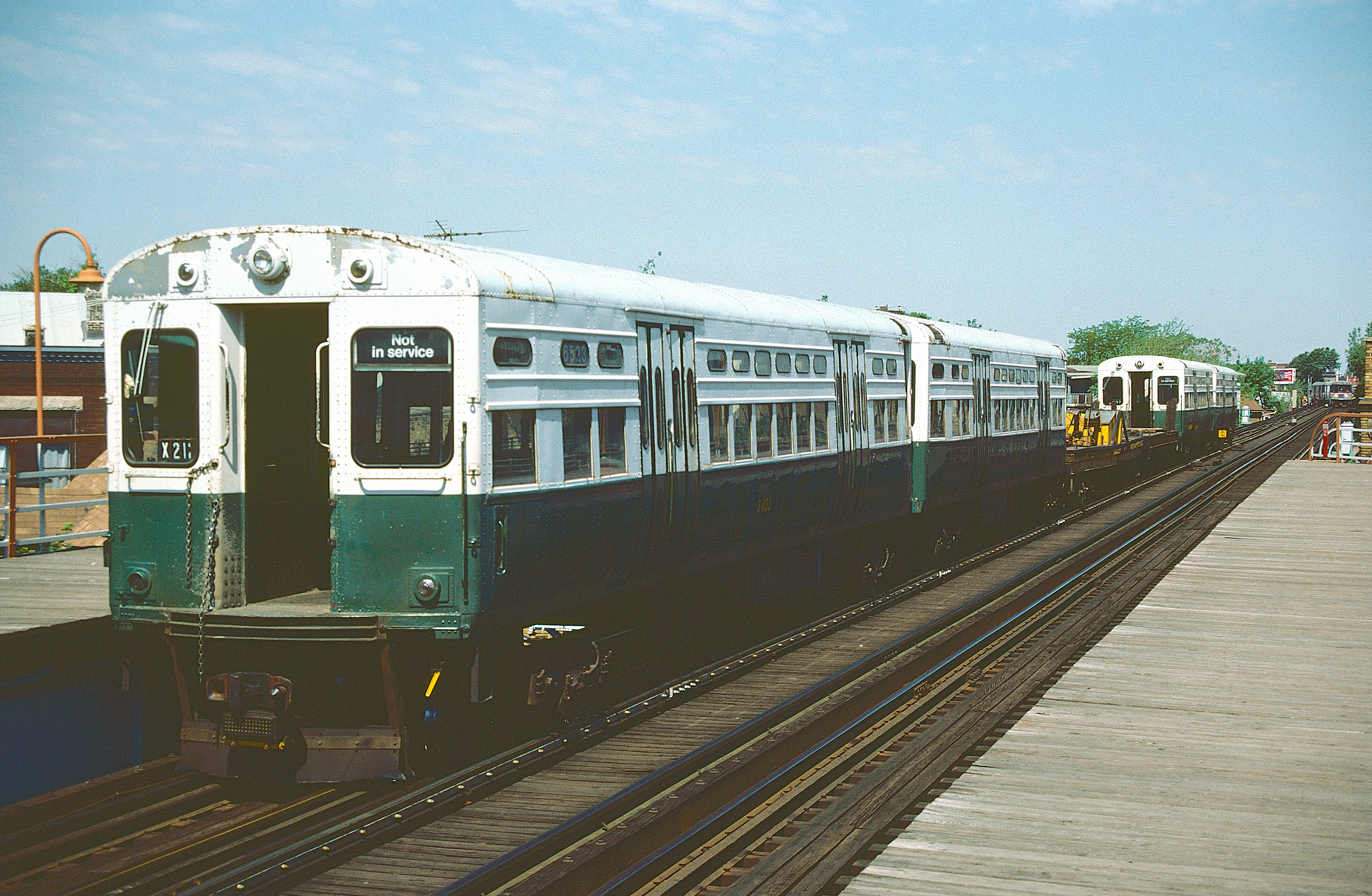|
Fox River Trolley Museum
The Fox River Trolley Museum is a railroad museum in South Elgin, Illinois. Incorporated in 1961 as R.E.L.I.C. (Railway Equipment Leasing and Investment Co.), it opened in 1966 and became the Fox River Trolley Museum in 1984. Location The museum is located at 365 South LaFox Street (Illinois Route 31), approximately two blocks south of the intersection of LaFox and State Streets. Collection The museum maintains a collection of 30 antique electric trolleys, railroad cars, and locomotives which range in construction dates from 1887 to 1959. The majority of the museum collection is focused on railways and electric transit lines of the Chicago area. One of the most exceptional cars in this collection is the wooden interurban (inter-city) Chicago Aurora and Elgin Railroad car #20, purchased directly from CA&E after that railroad discontinued passenger service. Car #20 was constructed in 1902 and is the oldest electric interurban car operating in the United States. The most recent ... [...More Info...] [...Related Items...] OR: [Wikipedia] [Google] [Baidu] |
South Elgin, Illinois
South Elgin is a village in Kane County, Illinois, United States. Per the 2020 census, the population was 23,865. In 2007, ''Money'' magazine named South Elgin as 82nd of 100 entries in its "America's Best Places to Live" edition and again in 2011 as 98th of 100 entries. History South Elgin was originally called "Clintonville", in honor of early settler James Clinton. The name "South Elgin" was adopted in 1907. Geography South Elgin is located in eastern Kane County at (41.992283, -88.307858), in the Fox River Valley. It is bordered to the north by the city of Elgin and to the east by the village of Bartlett. South Elgin sits on both sides of the Fox River. According to the 2010 census, South Elgin has a total area of , of which (or 97.67%) is land and (or 2.33%) is water. Demographics 2020 census ''Note: the US Census treats Hispanic/Latino as an ethnic category. This table excludes Latinos from the racial categories and assigns them to a separate category. Hispa ... [...More Info...] [...Related Items...] OR: [Wikipedia] [Google] [Baidu] |
Chicago Transit Authority
The Chicago Transit Authority (CTA) is the operator of mass transit in Chicago, Illinois, United States, and some of its surrounding suburbs, including the trains of the Chicago 'L' and CTA bus service. In , the system had a ridership of , or about per weekday as of . The CTA is an Illinois independent governmental agency that started operations on October 1, 1947, upon the purchase and combination of the transportation assets of the Chicago Rapid Transit Company and the Chicago Surface Lines streetcar system. In 1952, CTA purchased the assets of the Chicago Motor Coach Company, which was under the control of Yellow Cab Company founder John D. Hertz, resulting in a fully unified system. Today, the CTA is one of the three service boards financially supported by the Regional Transportation Authority and CTA service connects with the commuter rail Metra, and suburban bus and paratransit service, Pace. Operations The Chicago Transit Authority provides service in Chicago a ... [...More Info...] [...Related Items...] OR: [Wikipedia] [Google] [Baidu] |
Warren And Saline River Railroad
The Warren and Saline River Railroad is an short-line railroad connecting Cloquet, Arkansas to the Arkansas Midland Railroad at Warren. It has always been independent of larger carriers, and was previously owned by the Potlatch Corporation, a lumber company, until January 2010. WSR is currently operated by the Arkansas Midland Railroad and was sold by Pinsly Railroad Company to sold to Genesee & Wyoming Industries in 2014. WSR traffic generally consists of outbound lumber and other forest products.Edward A. Lewis, American Shortline Railway Guide, 5th Edition, Kalmbach Publishing, 1996, p. 326 History The Warren, Johnsville and Saline River Railroad was incorporated in August 1905 to serve logging operations in Bradley County. It opened a line from Warren south to Fullerton that year, and completed extensions from Fullerton to the Chicago, Rock Island and Pacific Railroad near Hermitage in 1909 and to Goepel (Mt. Olive) in 1910. Interstate Commerce Commission, 119 I.C.C. ... [...More Info...] [...Related Items...] OR: [Wikipedia] [Google] [Baidu] |
San Francisco Municipal Railway
The San Francisco Municipal Railway (SF Muni or Muni), is the public transit system for the City and County of San Francisco. It operates a system of bus routes (including trolleybuses), the Muni Metro light rail system, three historic cable car lines, and two historic streetcar lines. Previously an independent agency, the San Francisco Municipal Railway merged with two other agencies in 1999 to become the San Francisco Municipal Transportation Agency (SFMTA). In 2018, Muni served with an operating budget of about $1.2 billion. Muni is the seventh-highest-ridership transit system in the United States, with rides in , and the second-highest in California after the Los Angeles County Metropolitan Transportation Authority. Operations Most bus lines are scheduled to operate every five to fifteen minutes during peak hours, every five to twenty minutes middays, about every ten to twenty minutes from 9 pm to midnight, and roughly every half-hour for the late night "owl" ro ... [...More Info...] [...Related Items...] OR: [Wikipedia] [Google] [Baidu] |
6000 Series (Chicago 'L')
The 6000-series was a series of "L" cars built between 1950 and 1959 by the St. Louis Car Company for the Chicago Transit Authority. A total of 720 cars were produced, and remained in operation on the "L" until 1992. Design In 1947–1948 the Chicago Transit Authority received four three-car articulated trainsets, 5001–5004, to test PCC technology in rapid transit use. Two sets of cars were built by Pullman, two by St. Louis Car, with equipment supplied by competing suppliers, in order to test them directly against each other. The 6000-series was designed with knowledge from the 5000-series. The design would influence the G series for the Toronto subway. Bodies 5000-series bodies had a curved profile previously used by North Shore Line and then Chicago, Aurora & Elgin cars which operated on the "L". The floor width was the needed for platform clearance, then above the sides curved outward, so the car was wider at seat level. This profile was used, 6000-series cars w ... [...More Info...] [...Related Items...] OR: [Wikipedia] [Google] [Baidu] |
Skokie Swift
The Yellow Line, alternatively known as the Skokie Swift, is a branch of the Chicago "L" in Chicago, Illinois. The route runs from the Howard Terminal on the north side of Chicago, through the southern part of Evanston and to the Dempster Terminal in Skokie, Illinois making one intermediate stop at Oakton Street in Skokie. At Howard, Yellow Line passengers can transfer to the Purple or Red Lines of the "L". The Yellow Line is the only "L" line that does not go to The Loop and is the only "L" train route that is fully ADA accessible. It is also unique in that it runs in a below-grade trench for part of its length, even though it has no underground portions and does not run in an expressway median. It also includes grade segments and crossings at the northern portion of the line. It was built using the tracks of the former Chicago North Shore and Milwaukee Railroad's high-speed Skokie Valley Route. Extending the line to Old Orchard Mall in Skokie has been discussed. At one ... [...More Info...] [...Related Items...] OR: [Wikipedia] [Google] [Baidu] |
PCC Streetcar
The PCC (Presidents' Conference Committee) is a streetcar (tram) design that was first built in the United States in the 1930s. The design proved successful in its native country, and after World War II it was licensed for use elsewhere in the world where PCC based cars were made. The PCC car has proved to be a long-lasting icon of streetcar design, and many remain in service around the world. Origins The "PCC" initialism originated from the design committee formed in 1929 as the "Presidents' Conference Committee", renamed the "Electric Railway Presidents' Conference Committee" (ERPCC) in 1931. The group's membership consisted primarily of representatives of several large operators of U.S. urban electric street railways plus potential manufacturers. Three interurban lines and at least one "heavy rail", or rapid transit, operator—Chicago Rapid Transit Company—were represented as well. Also included on the membership roll were manufacturers of surface cars (streetcars) and i ... [...More Info...] [...Related Items...] OR: [Wikipedia] [Google] [Baidu] |
Cincinnati Car Company
The Cincinnati Car Company or ''Cincinnati Car Corporation'' was a subsidiary of the Ohio Traction Company. It designed and constructed interurban cars, streetcars (trams) and (in smaller scale) buses. It was founded in 1902 in Cincinnati, Ohio. In 1928, it bought the Versare Car Company. The company was among the first to make lightweight cars. Its chief engineer Thomas Elliot designed the curved-side car, a lightweight model that used curved steel plates (not conventional flat steel plates) in body construction. Instead of the floor, the side plates and side sills bore the bulk of the weight load. Longitudinal floor supports were no longer needed, which made the cars lighter than conventional cars. The first cars of this type were sold in 1922. For instance, the Red Devil weighted only . Curved-side cars were also called "Balanced Lightweight Cars". In 1929, the company designed new lightweight partially aluminum low profile high-speed coaches for the electrified Cincinnati an ... [...More Info...] [...Related Items...] OR: [Wikipedia] [Google] [Baidu] |
Chicago Surface Lines
The Chicago Surface Lines (CSL) was operator of the street railway system of Chicago, Illinois, from 1913 to 1947. The firm is a predecessor of today's publicly owned operator, the Chicago Transit Authority. History The first streetcars in Chicago were horse cars run by the Chicago City Railway Company and the North Chicago City Railway Company around 1858-1861. This method was slow and expensive, and the companies began substituting cable cars in the 1880s. Chicago City Railway was the first in (1881), and with the addition of the Chicago Passenger Railway (1883) and the West Chicago Street Railroad Company (1887), Chicago had the largest cable railway system in the world. The north and west side cable car systems were constructed by an investment syndicate under the direction of Charles Yerkes. It was also in the 1880s that electric-powered " trolleys" first became practical. The Chicago companies hesitated at first to install these faster and more efficient systems beca ... [...More Info...] [...Related Items...] OR: [Wikipedia] [Google] [Baidu] |
Chicago Rapid Transit Company
The Chicago Rapid Transit Company (CRT) was a privately owned firm providing rapid transit rail service in Chicago, Illinois and several adjacent communities between 1924 and 1947. The CRT is one of the predecessors of the Chicago Transit Authority, Chicago's current mass transit operator. Leading up to the consolidation of the 'L' companies into the CRT was decades of the Chicago Elevated Railways Collateral Trust (CER), an entity directly attributed to utilities magnate Samuel Insull. CER laid the groundwork for the companies to become one, including financial agreements and simplification that allowed for free transfers between the various lines at the places where they shared facilities, such as at Loop elevated stations. CER also resulted in the through-routing of trains from one company's line to another, enabling riders to take a single train from Ravenswood on the Northwestern 'L' to 35th Street on the South Side 'L'. The CRT was an amalgamation of several elevated ra ... [...More Info...] [...Related Items...] OR: [Wikipedia] [Google] [Baidu] |

.jpg)





